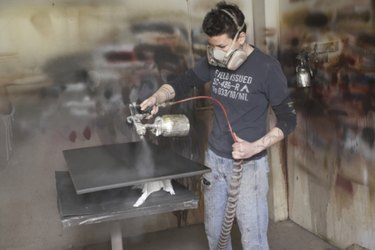Things You'll Need
1 gallon lacquer
1 clean gallon paint can
Lacquer thinner
Stirring stick
Quart-pressure pot spray gun

If you are having problems with lacquer, such as bubbles, extended drying times, or rough finishes, you might need thinner lacquer. Thick lacquer will not spray or dry correctly. When lacquer has the correct consistency, it atomizes in the air; when it comes into contact with the wood, the atomized particles reform into a glassy sheet. When the consistency is right, air is allowed to escape from the lacquer as it dries. If the lacquer is too thick, air is trapped under the lacquer, causing problems. To remedy this, thin it with lacquer thinner.
Step 1
Pour half of the lacquer into a clean gallon can.
Video of the Day
Step 2
Pour 1 pint of lacquer thinner into the can and mix it in with a flat stick.
Step 3
Pour the thinned lacquer into the spray gun and test it by spraying it on some scrap wood. Let the lacquer dry on the wood for 30 minutes.
Step 4
Examine the dry lacquer. If you are still having trouble with it, add another pint of lacquer to the already thinned lacquer and test again.
Tip
It is not advisable to thin the lacquer more than twice, but in extreme cases, such as older lacquer that has evaporated some, you can do it.
Warning
Add one pint at a time until the consistency works well in a spray gun. Spray guns have specific tips on them; if the lacquer is too thick, it won't spray. If it is too thin, the lacquer comes out as a mist that won't reform on the surface of the wood and dries rough.
Always wear safety glasses and breathing protection when working with lacquer or any finishing product. Use only in well-ventilated areas.
Video of the Day